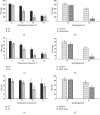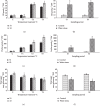Effects of Climate Temperature and Water Stress on Plant Growth and Accumulation of Antioxidant Compounds in Sweet Basil (Ocimum basilicum L.) Leafy Vegetable
- PMID: 32190405
- PMCID: PMC7068138
- DOI: 10.1155/2020/3808909
Effects of Climate Temperature and Water Stress on Plant Growth and Accumulation of Antioxidant Compounds in Sweet Basil (Ocimum basilicum L.) Leafy Vegetable
Erratum in
-
Corrigendum to "Effects of Climate Temperature and Water Stress on Plant Growth and Accumulation of Antioxidant Compounds in Sweet Basil (Ocimum basilicum L.) Leafy Vegetable".Scientifica (Cairo). 2020 Nov 27;2020:9362517. doi: 10.1155/2020/9362517. eCollection 2020. Scientifica (Cairo). 2020. PMID: 33343965 Free PMC article.
Abstract
The effects of climate temperature and water stress on growth and several stress markers were investigated in sweet basil plants. Some growth parameters (shoot length and number of leaves) and photosynthetic chlorophyll contents were determined every two days during plant growth, and foliage leaf material was collected after 15 and 21 days of treatment. Both climate temperature and water stress inhibited sweet basil plant growth; especially, total chlorophyll levels were decreased significantly in response to high-temperature treatments. Under strong stresses, basil plants induced the synthesis and accumulation of glycine betaine (GB) as a secondary osmolyte, although at less content when compared with the proline content under the same stress conditions. Proline concentrations particularly increased in leaves of both basil stressed plants, accomplishing levels high enough to play a crucial role in cellular osmoregulation adjustment. Stress-induced accumulation of these antioxidant compounds was detected in sweet basil. Therefore, it appears that sweet basil-treated plants are able to synthesize antioxidant compounds under strong stress conditions. On the other hand, total sugar concentrations decreased in stress-treated basil plants. Both temperature and water stress treatments caused oxidative stress in the treated plants, as indicated by a significant increment in malondialdehyde (MDA) concentrations. An increase in total phenolic and flavonoid concentrations in response to water stress and a highly significant decrease in carotenoid concentrations in basil leaves were observed; flavonoids also increased under high climate temperature conditions.
Copyright © 2020 Asma Al-Huqail et al.
Conflict of interest statement
The authors declare that they have no conflicts of interest.
Figures





References
-
- Chen H., Jiang J.-G. Osmotic adjustment and plant adaptation to environmental changes related to drought and salinity. Environmental Reviews. 2010;18(NA):309–319. doi: 10.1139/a10-014. - DOI
LinkOut - more resources
Full Text Sources

